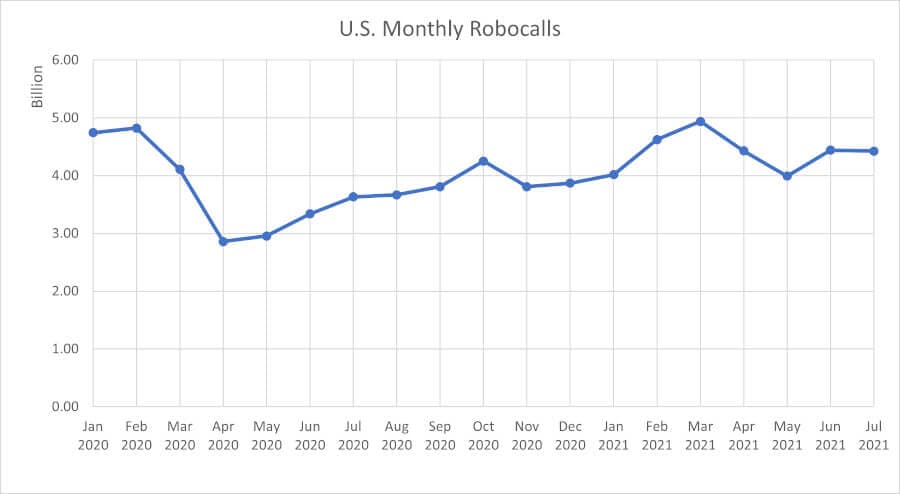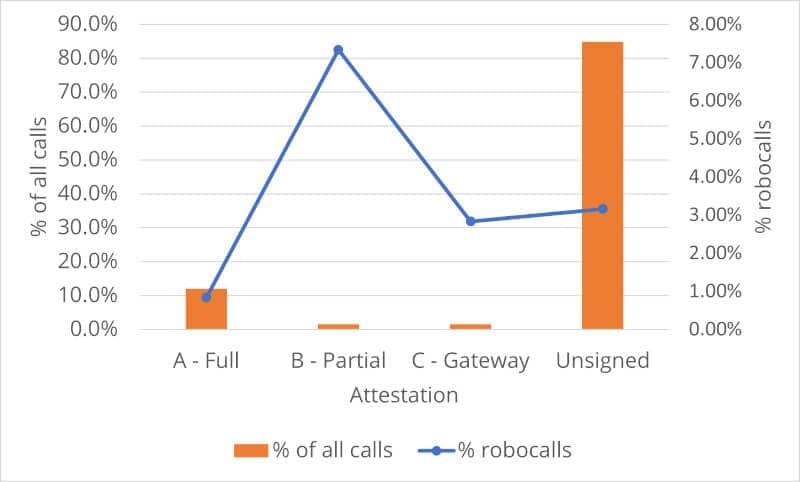Are SHAKEN and robocall mitigation preventing robocalls?
STIR/SHAKEN call authentication and/or robocall mitigation programs were mandated to be used starting June 30, 2021. So robocalls plummeted in July 2021, yes? Well, not exactly. Let’s have a look.

Figure 1: Monthly Robocalls Since January 2020
You may recall that robocalls plummeted from February through March 2020, mostly because call centers shut down during the pandemic. From April 2020, robocalls crept upward each month, reaching pre-pandemic levels by March 2021.
| Month | Robocalls | Difference | Percent |
|---|---|---|---|
| Jan 2021 | 4,016,613,000 | 147,205,000 | 3.8% |
| Feb 2021 | 4,623,874,200 | 607,261,200 | 15.1% |
| Mar 2021 | 4,939,870,400 | 315,996,200 | 6.8% |
| Apr 2021 | 4,427,314,500 | (512,555,900) | -10.4% |
| May 2021 | 3,991,129,400 | (436,185,100) | -9.9% |
| Jun 2021 | 4,441,444,300 | 450,314,900 | 11.3% |
| Jul 2021 | 4,426,771,600 | (14,672,700) | -0.3% |
Here’s the bad news: robocalls in July 2021 were down only 0.3% from June. The combination of STIR/SHAKEN and robocall mitigation programs deployed by the end of June didn’t make a dent in robocalls during July.
This doesn’t seem to be working. Why?

Call authentication
First, it’s helpful to remember that call authentication is necessary, but not sufficient, to prevent unlawful robocalls.
- Call analytics can prevent unlawful robocalls.
- But analytics are not as effective when the calling number is spoofed, especially neighbor spoofing a legitimate number.
- Call authentication is a powerful, essential input to call analytics to signal when the calling number was not spoofed.
We need STIR/SHAKEN and call analytics in order to make a dent in unlawful robocalls.
Robocalls by attestation level

Figure 2: Calls and Robocalls by Attestation Level
We shared this graph in a recent blog post on spam robocalls and SHAKEN attestation in July 2021. It tells an interesting story:
- 85% of calls are unsigned.
- 3% of calls were spam robocalls.
- Fewer than 1% of calls signed with Full Attestation (A) were spam robocalls.
- This is a significant improvement.
- However, full attestation doesn’t guarantee the call isn’t a spam robocall.
- Calls signed with Partial (B) or Gateway (C) attestation aren’t any better than unsigned calls.
- In fact, calls signed with partial attestation were much worse. 7.3% were spam robocalls!
Why were there so many spam robocalls signed with partial attestation? Many of these calls were signed by downstream providers for their upstream service provider customers.
Pathway to improvement
What’s it going to take to make a dent in spam robocalls? We think the pathway to improvement must include these steps:
- Originating service providers should use both robocall mitigation and SHAKEN. They go together. Neither is sufficient without the other.
- There needs to be more widespread use of SHAKEN. The recent approval of ATIS standards for non-IP call authentication provide effective ways to bring many more calls into the SHAKEN ecosystem.
- Something needs to be done about spam robocalls signed by downstream providers with partial attestation. Clearly, this is not working as intended.
TransNexus solutions
We offer STIR/SHAKEN and robocall mitigation solutions in our ClearIP and NexOSS software platforms. We can make your STIR/SHAKEN deployment a smooth process.
In addition, we help service providers with all aspects of STIR/SHAKEN deployment, including registering with the Policy Administrator and filing their certification with the FCC.
Contact us today to learn more.
Our STIR/SHAKEN products:
- Work with your existing network
- Support SIP and TDM
- Affordable, easy to deploy